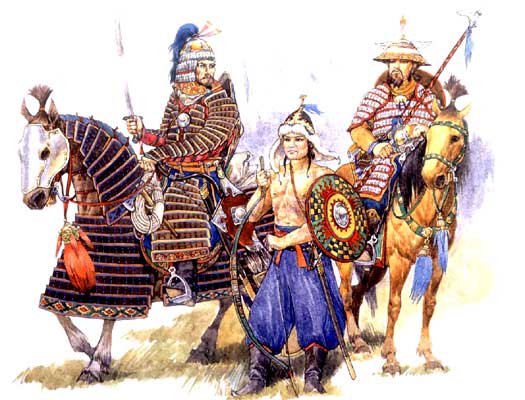In 1388 Yisüder, a descendant of Qubilai Khan’s brother ARIQ-BÖKE, murdered the emperor Toghus-Temür, initiating a complex period of usurpation and conflict. On one side stood the Oirats in the northwest, first under Möngke-Temür (fl. 1400) and by 1403 under three chiefs, Mahmud (d. 1417), Taiping (d. 1426), and Batu-Bolod. The Oirats drew to their side the descendants of Ariq- Böke and other princes who had been relegated to Mongolia during the Yuan. Against them stood Arugtai (d. 1434) of the Asud, active from 1403 on in HULUN BUIR. The Asud (OSSETES) had been an important unit in the Mongol imperial guard in the Yuan, and Arugtai apparently spoke for the old Yuan court.
Another force was the line of ÖGEDEI KHAN, which under the Yuan had lived in China’s Gansu area but were expelled along with the Yuan. The khan Guilichi (murdered 1408), reigning with Arugtai as his commander in 1400, had his base in southwest Inner Mongolia at Ejene and was apparently an Ögedeid. Farther to the west were the Chinggisid khans of MOGHULISTAN, based in modern Xinjiang, and TIMUR and his dynasty beyond them. Arugtai’s new khan after Guilichi, Bunyashiri (Öljeitü, r. 1408–12), came from Temür’s court in Samarqand in 1405, whence he had fled in opposition to the Oirats.
Under Yongle (1402–24) the Ming dynasty intervened aggressively against any overpowerful leader, exacerbating the Mongol-Oirat conflict. In 1409 Bunyashiri and Arugtai crushed a Ming army, so that in 1410 Yongle attacked the two on the KHERLEN RIVER. In 1412 Mahmud of the Oirats killed Bunyashiri, enthroning an Ariq-Bökid, Dalbag (1412–14). Arugtai appealed to the Yongle emperor, who in 1414 defeated Mahmud. With Mahmud’s death in 1417 Arugtai became dominant again, and Yongle campaigned against him in 1422 and 1423, ending when news of Arugai’s defeat by the Oirats arrived. From Yongle’s death, however, Mahmud’s son Toghoon Taishi (d. 1438) built up power without interruption. In 1433 Arugtai was pushed east of the GREATER KHINGGAN RANGE, where he subjugated the Ming-allied Mongols in the THREE GUARDS. Finally, after a great defeat in 1434, Arugtai fled west to the Muna Uula Mountain (west of Baotou), where Toghoon killed him. Arugtai’s khan, Adai (1426–38), another Ögedeid based in Ejene, made a last stand there before succumbing.
Toghoon died in the very year of his final victory over Adai. His son ESEN Taishi (r. 1438–54) brought the Oirats to the height of their power. In the west he drove back the Moghulistan rulers, while to the east he destroyed the Three Guards and the Jurchen. In 1449 he captured the Ming emperor, bringing about a wholesale collapse of the Ming defense line. The Three Guards streamed south to the Shara Mören (Xar Moron) valley, while they and fragments of virtually every other Mongolian group poured into the Huang (Yellow) River bend and ORDOS. Esen ruled as the taishi for the khan Togtoo-Bukha (reign name Taisung, 1443–52), but after punishing his restive Chinggisid khan in winter 1451–52, Esen took the title khan himself, the first non- Chinggisid to do so. Esen was, however, soon overthrown by his own chingsang (grand councillor) of the right, Alag.
From Esen’s death to 1481 the Oirats ceded power among the Mongols to taishis of obscure origin. Bolai Taishi (fl. 1457–66) seems to have inherited Esen’s titles and men but belonged to the KHARACHIN, descendants of the YUAN DYNASTY’s Qipchaq KOUMISS brewers. After a period of domination by Muulikhai Ong, a descendant of Chinggis’s half-brother Belgütei and closely allied to the Three Guards, there appeared three taishis, Beg-Arslan (d. 1479), Ismayil (d. 1486), and Iburai (perhaps from Ibrahim, d. 1533), all active in the Ordos (Huang [Yellow] River bend) area. Most Mongolian sources call them Uighurs, and Beg-Arslan and Ismayil certainly had ties to the Uighur oasis-city of Hami. The Uighur otogs (camp districts; see OTOG) among the TÜMED and Ordos along the Huang (Yellow) River seem to have been the power base for these western adventurers.
The importance of the Huang (Yellow) River bend increased when the EIGHT WHITE YURTS, or the shrine of Chinggis Khan, moved there around 1450. Perhaps from Adai’s reign on (1426–38), khans were crowned before the shrine. The Chinggisid ruler of the shrine, the jinong, a title first seen in 1452, became under Bayan-Möngke Bolkhu Jinong (fl. 1470–79) an important figure. The death of the Oirat taishi Toghoon at the height of his power in 1438 was turned into an illustration of the shrine’s power. In the Mongolian chronicle ALTAN TOBCHI (c. 1655), Toghoon decided to become great khan before the Eight White Yurts but was supernaturally slain, thus proving that only descendants of Chinggis could be khans.
